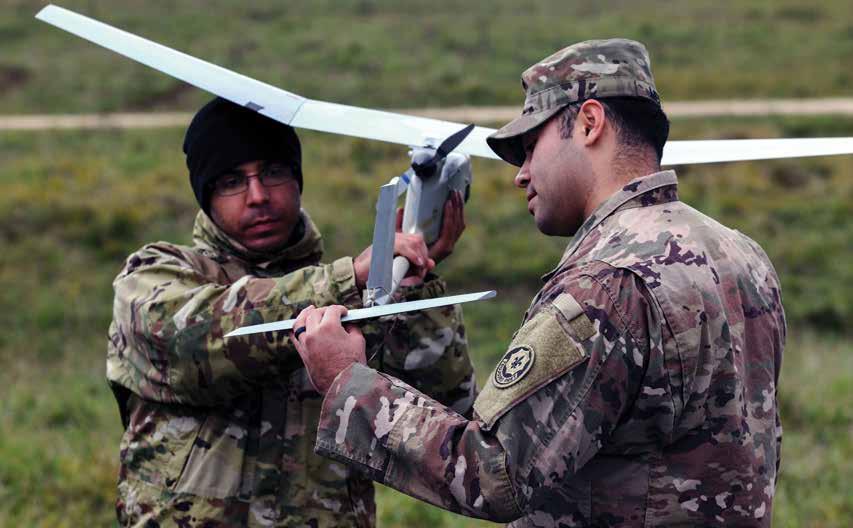
5 minute read
Editor’s Choice for October
The software algorithms that implement these applications can be divided into various categories. Each category has unique characteristics and software libraries that allow application developers to leverage basic operations. Often, these libraries enable the utilization of specialized processor hardware or software instruction sets that enable highperformance and/or power-efficient execution.
Computer vision (CV) algorithms utilize operations that extract features from images or video captured by imaging sensors – whether electro-optical, infrared or other parts of the electromagnetic spectrum. CV operations extract information from these two-dimensional images, or from the additional dimension of time in the video, through filters that tend to identify edges, patterns, colors, and changes thereof. CV algorithms often utilize graphics processing unit (GPU) hardware with computation units optimized for the basic operations that enable power- and time-efficient parallel execution. Common CV libraries include OpenCV and Open VX.
Machine learning (ML) algorithms enable a computational resource to learn from datasets, whether pre-determined before deployment or on-the-fly once deployed, characteristics that can subsequently be utilized for analyzing and classifying a current situation. ML algorithms execute most efficiently on dedicated hardware such as a neural processing unit (NPU). Example ML libraries include TensorFlow and oneAPI Deep Neural Network Library (oneDNN). ML algorithms may utilize data from one or multiple sensors of various types to develop models of typical and atypical conditions.
Artificial intelligence (AI) utilizes ML, CV, and other algorithms to allow a computer to perform human-like analysis based on data to predict future events or take actions based on very complex sets of data.
Intelligent sensor applications utilize a combination of software technologies to analyze sensor data, recognize target features of interest or anomalies, and automatically take action based on this analysis and recognition. Depending on the application and sensors, various combinations of traditional, ML, CV, and AI techniques may be used. Data from disparate sensors can be synchronized and correlated. A deterministic real-time operating system (RTOS) may be utilized to ensure the synchronization of multi-sensor data sets for maximum accuracy.
The complexity of today’s processors and application software, while enabling new intelligent edge sensor paradigms, also provides developers with significant amounts of work and risk in deploying new them. Time-tomarket, development costs and risk can be minimized through the use of commercial off-the-shelf (COTS) computing engines.
COM-HPC – New High-Performance Embedded Computing Standard
Over the years, several standards have been developed for high-performance computing (HPC). Chassis-based sys-tems such as VPX and the older VME offer the ultimate in rugged performance and the use of a combination of COTS and custom plug-in boards. They allow for the relatively rapid development of complex systems for military applications. However, their size, weight, power, and cost limit their utility for many edge sensor applications where small size, lower power availability, and need for lower costs are required.
PICMG’s COM-HPC specification, ratified in early 2021, is targeted for applications of more limited deployments. This new standard form factor, successor to COM Express, utilizes a two-board architecture consisting of a COMHPC computer-on-module (COM) which hosts a complete computing engine and an applicationspecific carrier board designed to host the COMHPC module and associated peripheral circuitry and interfaces to sensors.
COM-HPC provides board sizes ranging from 95 mm x 120 mm to 200 mm x 160 mm and provides module power budgets of up to 300W on server modules and up to 200W on client modules. This enables the use of small formfactor edge applications and entirely new classes of processors, including server-class CPUs, GPUs, FPGAs, and heterogeneous systems on the chip.
COM-HPC provides a wealth of very high bandwidth I/O capability through its two 400-pin connectors. This includes ultra-high performance interfaces such as 100 GbE, 40 Gbps USB4, and x64 lanes of PCIe Gen 4.0 or 5.0, the latter of which delivers up to 32 GTps data transfer speeds. Adding lower speed, legacy interfaces such as UART, I2C, SPI, and GPIO, COM-HPC provides the ability to interface broad varieties of sensors – from high-resolution array sensors that require PCIe to lower bandwidth environmental sensors.
An example COM-HPC module suitable for intelligent edge sensor computing is SECO’s LAGOON COM-HPC Client size A module, which leverages the 11th generation Intel® “Tiger Lake H” mobile processors ranging from octal-core Xeon® to Core™ devices – on Intel’s IoT Group roadmap for industrial temperature range and long-term availability. The processors include up to 32 execution units of Intel® Iris® Xe graphics. Utilizing 20x PCIe Gen 4.0 lanes, 20x PCIe Gen 3.0 lanes, and two 2.5 GbE interfaces, two to four USB 4 interfaces with bandwidths up to 40 Gbps, An intelligent sensor developer, integrating the LAGOON module on a custom-designed carrier board, can interface up to 15 separate PCIe sensor endpoints, up to 12 USB devices, two 2.5 GbE interfaces, and several serial-based sensors - enabling a single microprocessor to analyze

and correlate a large number of sensors within a relatively small form-factor.
Combining the conventional, AI, and CV processing power of these processors with the COM-HPC standard, a powerful but relatively power- and size-efficient computing platform implements complex intelligent edge sensors, including sensor fusion applications.
Intelligent Edge Sensors – Marriage of High-Performance Computing with Intelligent Algorithms
Current and next-generation microprocessors, with their artificial intelligence, machine learning, and computer vision hardware accelerators and associated software libraries that utilize them, enable new levels of edge sensor intelligence. With greater processing capabilities enabled with AI, ML, and CV algorithms, ultra-high bandwidth interfaces, and lower power envelopes, intelligent edge sensors allow for unheard-of lev-els of situational awareness analyzed with minimal lat-ency that allows for autonomous action – avoiding scenarios where disrupted chains of communications may prevent the use of sensor data. With current-generation microprocessors, compact but wide data interfaces en-abled by standards such as COM-HPC, and through the use of AI, ML, and CV algorithms, intelligent edge sensors will gain use in deployed applications.




